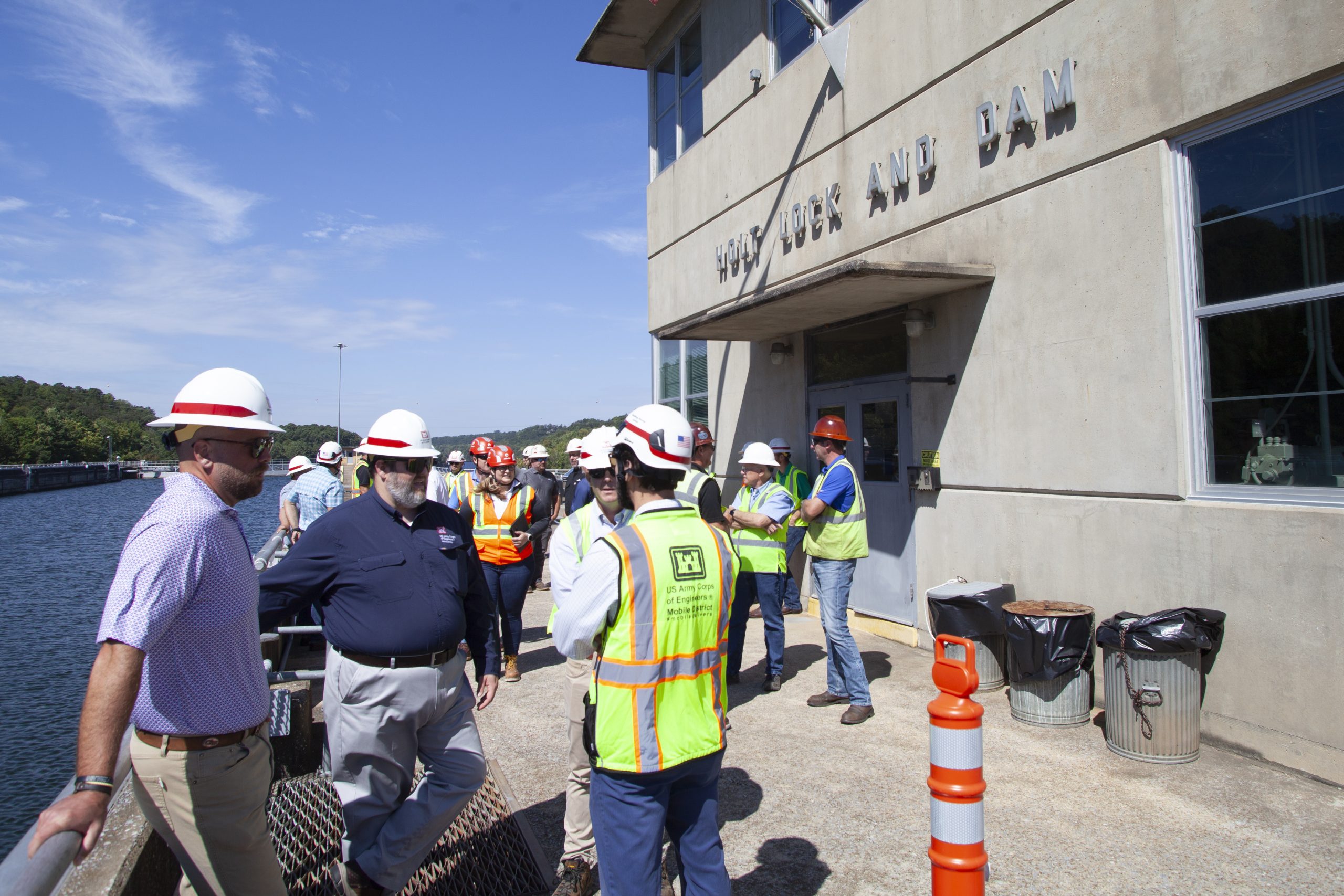By Cheryl Wray and Frank McCormack
Holt Lock, located at Mile 347 on the Black Warrior River near Tuscaloosa, Ala., could be just a few weeks away from reopening to navigation if all goes well with temporary repairs to address cracks in one of the lock’s river-side monoliths.
“We’ve got a lot of good progress going on at Holt,” said Nelson Sanchez, operations division chief for the Mobile Engineer District.
The Mobile District closed Holt Lock on June 22 due to serious and worsening cracks and leaks in one of the lock’s concrete monoliths. Through instrumentation readings, remotely operated vehicle (ROV) inspections and dye tests, the Corps identified cracks extending from one of the lock’s culverts extending all the way up to the top of the lock wall, with water leaking through the monolith into the lock chamber and into the machinery room beneath the lock operator’s office.
The Corps is attempting a temporary repair at the lock, which will involve installing a bulkhead in front of the problematic culvert, isolating it from the water pressure of raising and lowering the pool in the lock chamber. The process for the temporary repair includes bulkhead fabrication, guide frame assembly and installation, and bulkhead installation and securement.
R&D Maintenance is the lead contractor for the bulkhead installation. Moundville, Ala.-based Alabama Mechanical Inc. is fabricating the bulkhead.
Sanchez, speaking September 11 during a weekly stakeholders conference call, said the guide frame should be complete around September 15, with the bulkhead arriving at the lock soon thereafter.
“It looks like the bulkhead will be delivered on the 18th of September,” Sanchez said. “They’ll assemble the three pieces. Hopefully, they’ll install it on the 26th of September or at the end of the month. We’re still tracking a good schedule there.”
The guide rails for the bulkhead were delivered in August, with a dive team drilling cores and installing the guide frame assembly ever since.
“We’ve had divers on site seven days a week,” said Anthony Perkins, operations project manager for the Black Warrior-Tombigbee Waterway, speaking during an August 29 users and operators meeting in Tuscaloosa. “It’s a 90-foot dive, so it takes a lot of time, and divers have to rest, but they are working hard and almost constantly.”
Once the bulkhead is installed, Corps officials will cycle the lock and assess its stability. If the safety factor is sufficient, the lock will be able to open to navigation while the Corps prepares for permanent or long-term repairs.
“If the bulkhead works, the lock will be open from October until about February or March,” Sanchez said. “We’ll work with industry to see what we can do to help you clear your backlog, as well as [develop] a schedule for next year to do the permanent fix.”
Sanchez said his “confidence level is pretty good” that the bulkhead will provide enough stability to be able to open the lock to navigation. Still, the Corps won’t know for sure until the bulkhead installation is complete and engineers assess its stability. That assessment could about a week to complete.
Permanent or long-term repairs aren’t expected to begin until next year. That work will involve installing anchor rods and pressure grouting cracks. The installation of both vertical and horizontal post tension anchor rods will effectively “sew” the monolith back together. The cracks extend the full height and full width of the monolith.
Scott Ellzey, the project manager for the permanent fix, told waterway stakeholders that the Corps hosted a total of 13 contractors for a September 4 industry day. The meetings with potential contractors were fruitful from a scheduling and strategy standpoint, Ellzey said. One key determination from the industry day was that contractors said they could install the post tension anchor rods “in the wet.” Ellzey said one item of discussion among repair contractors was how to balance opening the lock to navigation with an efficient construction schedule.
“It was pretty consistent across the board from all of the contractors,” Ellzey said. “They said three weeks on and one week off. We’ll have to work those details out and get waterway users’ input on that, but that was the contractors’ input on that.”
Ellzey then outlined the anticipated project schedule.
“We’ll go out with advanced notice in January,” Ellzey said. “In February, we’ll advertise and award in May.”
In that scenario, construction would wrap up by the end of next year.
Ellzey added that, if the bulkhead doesn’t provide sufficient stability, there could be a joint venture option that would accelerate the permanent repair.
Waterway users were vocal with their position on the thought of a three-weeks-closed, one-week-open schedule.
“Keep in mind that a trip from above Holt down to Mobile and back is going to take at best a week, if not a little bit longer,” said Chas Haun, executive vice president of Parker Towing Company. “You can do it quicker, but our turn times are about a week, so we would not be able to engage in normal traffic. I would think that for us it would be better if you worked five days a week and opened on the weekends.”
Tim Parker Jr., chairman of Parker Towing, concurred.
“We’re betting the farm that bulkhead works,” he said. “But that 3-to-1 ratio is a killer. The biggest problem we’re battling now is confidence in the river.”
Representatives from Cooper Marine also spoke up against the 3-to-1 construction schedule.
Sanchez and Ellzey both assured stakeholders that no construction schedule is set in stone.
“That’s why we brought it up here,” Ellzey said. “I did want to hear this feedback from you guys, and maybe we can set up a separate meeting to discuss it. I definitely think the five days and lockages during the weekends is possible. There’s no limits to what we can and can’t do in a contract.”
————
Photo caption: Contractors and Corps officials gathered at Holt Lock September 4 for an industry day. (Photo by Frank McCormack)



